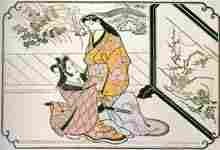Hishikawa Moronobu
Beauty Looking Back

Hishikawa Moronobu (Japanese: 菱川 師宣; 1618 – 25 July 1694) was a Japanese artist known for popularizing the ukiyo-e genre of woodblock prints and paintings in the late 17th century.[1]
Early life and training
Moronobu was the son of a well-respected dyer and a gold and silver-thread brocade artisan in the village of Hodamura, Awa Province, near Edo Bay in present-day Kyonan, Chiba Prefecture. After moving to Edo, Moronobu, who had learned his father's craft, studied both Tosa and Kanō-style painting. He thus had a solid grounding in both decorative crafts and academic painting, which served him well when he then turned to ukiyo-e, which he studied with his mentor, the Kanbun Master.
Work
Panel from a series of 12, in abuna-e style
Late 1670s–early 1680s; Hishikawa Moronobu (1618-1694); Woodcut, sumi ink on paper
His first known signed and dated works were book illustrations from 1672, although earlier works may yet surface. By the mid-1670s Moronobu had already become the most important ukiyo-e printmaker, a position he maintained until his death.[2] He produced more than 100 illustrated books, perhaps as many as 150, though it is difficult to attribute to him many unsigned examples (for example, the scholar Kiyoshi Shibui established, in 1926, a basis for crediting some of the designs previously given to Moronobu as the work of Sugumura Jihei). Very few of Moronobu's single-sheet prints have survived, and most, if not all, are unsigned. Among these single sheets are erotic album prints.
Moronobu was not the "founder" of ukiyo-e, as some early scholars surmised. Instead, he made an assimilation of inchoate ukiyo-e designs by previous artists, a consolidation of genre and early ukiyo-e painting and prints. It was Moronobu who created the first truly mature form of ukiyo-e, in a style of great strength and presence that would set the standards for generations of artists who followed. Moronobu's mastery of line has often been cited in assessments of his oeuvre, as well as the interactive arrangement of figures, which seem always to serve a dramatic function not usually seen in the work of his predecessors.
Beauty looking back
Some of Moronobu's prints are found with hand coloring, but this specimen is a 'sumizuri-e' (ja:墨摺絵) (print with black pigment only) in its original, uncolored state. There is something almost elemental in Moronobu's line work and figure placements in black and white, which most often was diminished into more decorative effects when colors were applied by hand. The black and gray lines and solid areas contrast boldly with the white paper to produce a range of tonal values, with emphasis on the shape and movement of the lines and the "positive" values of the white spaces. As in many other designs by Moronobu, the artist was inventive in his use of curvilinear forms juxtaposed against straight diagonals.
Groupings of 12 images had been common for centuries in court and genre paintings. Among the more famous surviving early specimens were the painted single sheets by the master Tosa Mitsunobu (1434–1525). Thus Moronobu's adoption of a grouping of 12 was conventional enough, particularly as such an arrangement afforded a context in which to alter the furnishings, clothing, and design patterns, matched more or less to the months of the year. However, it cannot be said that much 'shunga' strictly adhered to seasonal progressions or 12-step narratives. Moronobu's print qualifies as an 'abuna-e' ("risqué print"), a non-explicit erotic design of a type often found as the frontispiece to 'shunga' sets or occasionally interspersed among the explicit sheets. Moronobu's formalism is evident here, with curves and straight lines balanced in near perfect proportion. As for the amorous couple, the seduction has just begun with the loosening of the obi (the woman's sash). Erotic signifiers enhance the scene. For example, the young beauty raises her right sleeve toward her mouth in a gesture of suppressed emotion. Water imagery evokes the woman's sexuality, with feminine or 'yin' erotic symbols in the garden stream behind the lovers and in the waves on the robe of the young gallant, while the flowering ume on the standing screen serves as a metaphor for male or 'yang' sexuality.
Moronobu's work is held in the collection of the Library of Congress.[3]
Works
Lobby of a brothel from Yoshiwara no tei series, ca. 1680.
Shunga, early 1680s, private collection.
Ayame no Sikku, between 1650 and 1700, Brooklyn Museum.
Women dressmaking and artesans at work, between 1675 and 1695, Brooklyn Museum.
Gardens and Pavilions of Pleasure, late 17th century, Nelson-Atkins Museum of Art.
More examples of Moronobu's work can be found at Ukiyo-e Search.[4]
See also
References
Lyons, Martyn. "Books: A Living History". Getty Publishing, 2011, p 161.
"Moronobu". Encyclopedia of Japan. Tokyo: Shogakukan. 2012. Retrieved 2012-03-04.
"Pictorial Map of the Tōkaidō Highroad". World Digital Library. Retrieved 6 May 2013.
Resig, John. "Hishikawa Moronobu". Ukiyo-e Search, 2012. 23, February 2015.
External links
Ukiyoe The third story
Beauty looking back, Tokyo National Museum
Kabuki drama, Tokyo National Museum
---
Fine Art Prints | Greeting Cards | Phone Cases | Lifestyle | Face Masks | Men's , Women' Apparel | Home Decor | jigsaw puzzles | Notebooks | Tapestries | ...
---
Artist
A - B - C - D - E - F - G - H - I - J - K - L - M -
N - O - P - Q - R - S - T - U - V - W - X - Y - Z




